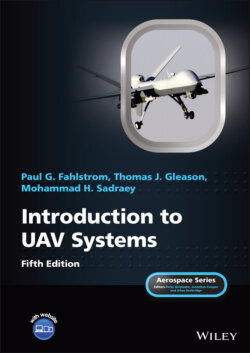Читать книгу Introduction to UAV Systems - Mohammad H. Sadraey - Страница 68
3 Aerodynamics 3.1 Overview
ОглавлениеAerodynamics is the science that involves the study of the behavior (i.e., dynamics) of air when confronting a moving object (e.g., air vehicle). The UAV has a number of components that are characterized by their aerodynamic outputs (e.g., lift), two of which are wing and tail. A wing/tail is considered as a lifting surface in which the lift is produced due to the pressure difference between lower and upper surfaces. In contrast, surfaces such as aileron, rudder, and elevator are referred to as the control surfaces. Lifting surfaces are generally fixed while control surfaces are always moving up/down or left/right. Both lifting and control surfaces are functions of their aerodynamic features.
The primary forces that act on an air vehicle are thrust, lift, drag, and gravity (or weight). They are shown in Figure 3.1. The UAV components that have a direct contact with moving air contribute to aerodynamic features. A number of elements have considerable contributions on an air vehicle’s aerodynamic features. They are mainly: (1) wing, (2) tail, (3) fuselage, (4) engine cowling, (5) landing gear, and (6) payload. Three primary aerodynamic components of an air vehicle are: (1) wing, (2) tail, and (3) fuselage.
The primary aerodynamic function of the wing and tail is to generate sufficient lift force or simply lift (L). However, they have two other undesirable products, namely drag (D) and nose‐down pitching moment (M). The fuselage is not fundamentally considered as an aerodynamic component based on its function. However, fuselage has a considerable role in creating drag, while it generates a little lift.
In this chapter, aerodynamic forces (mainly lift and drag), airfoil, pressure distribution, friction drag, induced drag, drag polar, air vehicle drag, boundary layer, and aerodynamic efficiency will be briefly covered.
